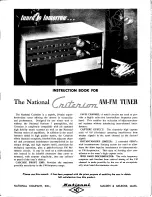
VHF RECEIVER
2-11
July 2000
Part No. 001-2000-720
2.3.4 RECEIVER FREQUENCY ADJUST
1. Place a pick-up loop (sniffer) or RF probe connected
to a frequency counter near TP102.
2. Set Y401 (TCXO) for the Injection Frequency
±50 Hz
(Inj Freq = chnl freq + 52.95 MHz).
2.3.5 VCO TEST
1. The software programs the synthesizer for
1 MHz above the receive channel.
2. The voltage on TP401 should be < 10V.
3. Record the voltage on TP401 __________.
4. The software programs the synthesizer for
1 MHz below the receive channel.
5. The voltage on TP401 should be > 4V.
6. Record the voltage on TP401 __________.
7. If the voltages recorded in Steps 3 and 6 are not
within
±
0.2V, tune L102 as required to balance the
voltage readings.
8. The software programs the synthesizer for the
receive frequency.
2.3.6 FRONT END ADJUSTMENTS
NOTE: Verify that the appropriate IF jumpers (J203,
J204, J205) are selected.
1. Set the signal generator to the receive frequency at a
level sufficient to produce an output voltage at
TP201 or J201, pin 7 (RSSI Output).
2. Tune CV101, CV102, CV103, CV104, CV105, and
CV106, then repeat, for a peak voltage at TP201.
Decrease the generator output level to maintain a
2-3V reading at TP201.
FOR 15 kHz CHANNELS:
NOTE: Perform this test if CV211 and CV212 are
placed on the board.
1. Set the generator to an RF level sufficient to produce
2V DC at TP201.
2. Remove any modulation from the signal generator.
3. Increase the signal generator RF frequency 2.5 kHz.
4. Adjust CV211 for peak DC voltage at TP201.
5. Adjust CV212 for peak DC voltage at TP201.
6. Reset the signal generator to the tune-up frequency.
7. Set the signal generator to 100
µ
V into the receiver
with a 1 kHz tone at
±
1.5 kHz deviation.
(1000
µ
V at the generator with 20 dB pad gives
100
µ
V at the receive antenna.)
8. Tune Z215 for 2V
±
0.05V at U203, pin 9.
9. Tune RV215 for 387 mV RMS,
±
5 mV RMS, at
TP202.
10.Adjust RV212 for 2V ±0.05V at TP202.
11. Connect a distortion analyzer to TP202.
12.Tune L211, L213, L214 and L216 for minimum
distortion <5%, (typically <3%).
13.Repeat Step 12 then Steps 8, 9 and 10.
FOR 30 kHz CHANNELS:
NOTE: Perform this test if CV201 and CV202 are
placed on the board.
1. Set the generator to an RF level sufficient to produce
2V DC at TP201.
2. Remove any modulation from the signal generator.
3. Increase the signal generator RF frequency 5 kHz.
4. Adjust CV201 for peak DC voltage at TP201.
5. Adjust CV202 for peak DC voltage at TP201.
6. Reset the signal generator to the tune-up frequency.
Содержание CONVENTIONAL VOTING RECEIVER
Страница 2: ... 2 February 1996 Part No 001 3039 505 ...
Страница 4: ... 4 February 1996 Part No 001 3039 505 ...
Страница 16: ...INTRODUCTION 1 6 July 2000 Part No 001 2000 720 ...
Страница 42: ...2 26 July 2000 Part No 001 2000 720 ...
Страница 64: ...UHF RECEIVER 3 22 July 2000 Part No 001 2000 720 ...
Страница 68: ...3 36 July 2000 Part No 001 2000 720 ...
Страница 86: ...800 MHz RECEIVER 4 18 July 2000 Part No 001 2000 720 ...
Страница 90: ...4 22 July 2000 Part No 001 2000 720 ...
Страница 112: ...5 22 July 2000 Part No 001 2000 720 ...
Страница 118: ...INTERFACE BOARD 6 6 July 2000 Part No 001 2000 720 ...
Страница 121: ...INTERFACE BOARD 6 9 July 2000 Part No 001 2000 720 ...
Страница 122: ...INTERFACE BOARD 6 10 July 2000 Part No 001 2000 720 Figure 6 3 RDM INTERFACE BOARD SCHEMATIC 1 OF 2 ...
Страница 123: ...INTERFACE BOARD 6 11 July 2000 Part No 001 2000 720 Figure 6 4 RDM INTERFACE BOARD SCHEMATIC 2 OF 2 ...
Страница 124: ...INTERFACE BOARD 6 12 July 2000 Part No 001 2000 720 ...
Страница 128: ...6 12 July 2000 Part No 001 2000 720 ...
Страница 130: ...6 2 July 2000 Part No 001 2000 720 ...
Страница 134: ...POWER SUPPLIES 8 4 July 2000 Part No 001 2000 720 ...
Страница 146: ...800 MHz RECEIVER CHANNEL FREQUENCY CHART A 12 July 2000 Part No 001 2000 720 ...
















































